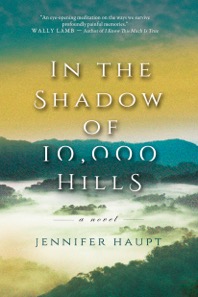In the Shadow of 10,000 Hills: A Novel
- By Jennifer Haupt
- Central Avenue Publishing
- 384 pp.
- Reviewed by K.L. Romo
- May 14, 2018
In this moving story spanning 30+ years, readers are taken on an intimate and anguished journey through the Rwandan genocide.

In 1965, young Henry Shepherd meets Lillian Carlson at the Ebenezer Baptist Church in Atlanta, where he is sent to take pictures of Martin Luther King Jr. His photo of this optimistic young girl and MLK captures the hope of a divided nation and is featured on the cover of Life magazine.
The fact that Henry is white and Lillian is black doesn’t prevent the spark that ignites a passion between them — their love for each other and their desire to change the world. But when Henry is attacked because he loves a black woman, he realizes the bubble of serenity he shares with Lillian is a dangerous illusion and returns to his native Florida.
Fear causes Henry to seek security in place of idealism. He settles for marriage with a woman he doesn’t love after she becomes pregnant, and then resigns himself to the dull work of ad-agency photography.
After Henry’s retreat, Lillian marries, but loses her new husband in the Vietnam War. Battling her grief, she moves to Kenya to teach at an orphanage, living out MLK’s message. In 1973, Lillian sends a letter to Henry telling him of her plans to open her own orphanage in Mubaro, Rwanda, at the foothills of the majestic Virunga Mountains.
After reading Lillian’s letter, Henry is torn between Rachel, the 7-year-old daughter he adores, and the woman he never stopped loving. And what of his yearning to document the world through his camera lens? Henry must choose between a life of fulfillment with his soulmate and a life with his beloved child.
Fast-forward to the year 2000. The now 33-year-old Rachel longs for a family, yearning for the father she hasn’t seen in over 25 years. If she can track down the woman on the cover of Life, she might be able to find the father who left her so many years ago.
She soon embarks on a journey to Rwanda.
Enter Nadine, Henry and Lillian’s adopted daughter, a Tutsi girl Henry saved from the 1994 mass killing in Mubaro. As Nadine and Rachel search for answers to heal their respective wounds, they discover how much they have in common, even though their lives are so very different. With the help of Nadine and Lillian, Rachel pieces together the last quarter-century of her father’s life and finally begins to understand him.
The 1990s Rwandan genocide committed by the Hutus against the Tutsis is the central theme connecting the characters of this beautiful and chilling novel and illustrates life in rural Rwanda both before and after the Slaughter, as Lillian calls it. As far as she’s concerned, genocide is too kind a term.
In 2006, author Jennifer Haupt spent a month in Rwanda interviewing survivors of the Slaughter, that dark event which killed over a million people. Rwandans believe that God lives in the 10,000 hills of Rwanda but became lost in the Rift Valley during the genocide, wandering for 90 days, trying to see through tears of despair. The soil there is now fertile from the remains of hundreds of thousands of bodies left after the killing.
Through her interviews, Haupt discovered the Rwandan people’s search for truth, justice, and reconciliation. This story screams to be heard by those of us fortunate enough to live in safety and prosperity.
We need to know what happened on the other side of the world; we need to feel the despair that was left after the genocide, and the new hope that’s dawning through what the Rwandans call amahoro — peace.
K.L. Romo writes about life on the fringe: Teetering dangerously on the edge is more interesting than standing safely in the middle. She is passionate about women’s issues, loves noisy clocks and fuzzy blankets, but HATES the word normal. Her historical novel, Life Before, is about two women separated by a century who discover they’ve shared a soul. Find her on Twitter at @klromo.

